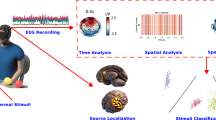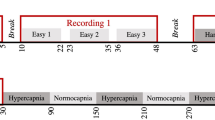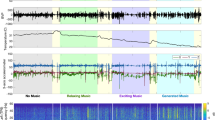Abstract
Background
Many studies have shown some relationships between thermal perception (including thermal sensation and thermal comfort) and human physiological parameters, such as brain signals. However, further research is still needed on how these parameters can help recognize the state of a human’s personal thermal perception.
Objective
This study aims to investigate the potential of using fNIRS brain signals to evaluate and predict personal thermal perception and cognitive performance in a steady-state temperature.
Methods
The present study investigated changes in the fNIRS signal during ambient temperature manipulation. Thirty healthy young individuals were selected as the subjects, and they were exposed to two steady temperatures of 28.8 and 19 °C. After acclimatizing to either temperature, the oxy/deoxy-hemoglobin changes of the prefrontal cortex (PFC) were measured in both rest and cognitive task states using 16-channel fNIRS.
Results
Results showed that exposure to different temperatures was significantly associated with the brain signals recorded during the task state. Many significant correlations were discovered between fNIRS signals and thermal perception indices. Furthermore, subjects’ performance changes led to changes in the fNIRS signals. Logistic regression showed that fNIRS can determine whether a person is thermally comfortable or uncomfortable.
This is a preview of subscription content, access via your institution
Access options
Subscribe to this journal
Receive 6 print issues and online access
$259.00 per year
only $43.17 per issue
Buy this article
- Purchase on Springer Link
- Instant access to full article PDF
Prices may be subject to local taxes which are calculated during checkout






Similar content being viewed by others
References
Oi H, Hashimoto T, Nozawa T, Kanno A, Kawata N, Hirano K, et al. Neural correlates of ambient thermal sensation: An fMRI study. Sci Rep. 2017;7:1–11.
Kim J, Schiavon S, Brager G. Personal comfort models – A new paradigm in thermal comfort for occupant-centric environmental control. Build Environ. 2018;132:114–24.
Liu W, Lian Z, Liu Y. Heart rate variability at different thermal comfort levels. Eur J Appl Physiol. 2008;103:361–6.
Fan X, Liu W, Wargocki P. Physiological and psychological reactions of sub-tropically acclimatized subjects exposed to different indoor temperatures at a relative humidity of 70. Indoor Air. 2019;29:215–30.
Mäkinen TM, Palinkas LA, Reeves DL, Pääkkönen T, Rintamäki H, Leppäluoto J, et al. Effect of repeated exposures to cold on cognitive performance in humans. Physiol Behav. 2006;87:166–76.
ANSI/ASHRAE Standard 55-2004: Thermal Environmental Conditions for Human Occupancy Approved. GA: American Society of Heating, Refrigeration and Air-Conditioning Engineers.
Sung EJ, Yoo SS, Yoon HW, Oh SS, Han Y. Brain activation related to affective dimension during thermal stimulation in humans: a functional magnetic resonance imaging study. Int J Neurosci. 2007;117:1011–27.
Kanosue K, Sadato N, Okada T, Yoda T. Brain activation during whole body cooling in humans studied with functional magnetic resonance imaging. Neurosci Lett. 2002;329:157–60.
Rolls ET, Grabenhorst F, Parris BA. Warm pleasant feelings in the brain. Neuroimage. 2008;41:1504–13.
Aizawa Y, Harada T, Nakata H, Tsunakawa M, Sadato N, Nagashima K. Assessment of brain mechanisms involved in the processes of thermal sensation, pleasantness/unpleasantness, and evaluation. IBRO Rep. 2019;6:54–63.
Lv B, Su C, Yang L, Wu T. Effects of stimulus mode and ambient temperature on cerebral responses to local thermal stimulation: An EEG study. Int J Psychophysiol. 2017;113:17–22.
Davis KD, Kwan CL, Crawley AP, Mikulis DJ. Functional MRI study of thalamic and cortical activations evoked by cutaneous heat, cold, and tactile stimuli. J Neurophysiol. 1998;80:1533–46.
Becerra LR, Breiter HC, Stojanovic M, Fishman S, Edwards A, Comite AR, et al. Human brain activation under controlled thermal stimulation and habituation to noxious heat: an fMRI study. Magn Reson Med J Int Soc Magn Reson Med. 1999;41:1044–57.
Craig AD, Chen K, Bandy D, Reiman EM. Thermosensory activation of insular cortex. Nat Neurosci. 2000;3:184–90.
Casey KL, Minoshima S, Morrow TJ, Koeppe RA. Comparison of human cerebral activation pattern during cutaneous warmth, heat pain, and deep cold pain. J Neurophysiol. 1996;76:571–81.
Moulton EA, Pendse G, Becerra LR, Borsook D. BOLD responses in somatosensory cortices better reflect heat sensation than pain. J Neurosci. 2012;32:6024–31.
Peltz E, Seifert F, DeCol R, Dörfler A, Schwab S, Maihöfner C. Functional connectivity of the human insular cortex during noxious and innocuous thermal stimulation. Neuroimage. 2011;54:1324–35.
Muzik O, Diwadkar VA. In vivo correlates of thermoregulatory defense in humans: Temporal course of sub‐cortical and cortical responses assessed with fMRI. Hum Brain Mapp. 2016;37:3188–202.
Hou L, Watanuki K Analysis of Brain Activity during Local Hot-Cold Stimulus Using Near-Infrared Spectroscopy (Analysis of Brain Activity During Hot Stimulation). In2015 IEEE International Conference on Systems, Man, and Cybernetics 2015:1526-31.
Yao Y, Lian Z, Liu W, Shen Q. Experimental study on physiological responses and thermal comfort under various ambient temperatures. Physiol Behav. 2008;93:310–21.
Yao Y, Lian Z, Liu W, Jiang C. Heart rate variation and electroencephalograph - The potential physiological factors for thermal comfort study. Indoor Air. 2009;19:93–101.
Watanuki K, Hou L, Kondou Y Evaluation of Human Thermal Comfort Using Near-Infrared Spectroscopy. In International Design Engineering Technical Conferences and Computers and Information in Engineering Conference 2014 Aug 17 (Vol. 46285, p. V01AT02A089). American Society of Mechanical Engineers.
Mansi SA, Pigliautile I, Arnesano M, Pisello AL A novel methodology for human thermal comfort decoding via physiological signals measurement and analysis. Building Environ. 2022; https://doi.org/10.1016/j.buildenv.2022.109385.
Lu M, Hu S, Hu Y, Zheng Y, Liu X, Zhao X, et al. Critical dynamic characteristics of brain activity in thermal comfort state. Building Environ. 2023; https://doi.org/10.1016/j.buildenv.2023.110632.
Zhu M, Liu W, Wargocki P. Changes in EEG signals during the cognitive activity at varying air temperature and relative humidity. J Expo Sci Environ Epidemiol. 2020;30:285–98.
Pan L, Zheng H, Li T Effects of the indoor environment on EEG and thermal comfort assessment in males. Building and Environment. 2023; https://doi.org/10.1016/j.buildenv.2022.109761.
Lan L, Lian Z, Pan L. The effects of air temperature on office workers’ well-being, workload and productivity-evaluated with subjective ratings. Appl Erg. 2010;42:29–36.
Nayak T, Zhang T, Mao Z, Xu X, Zhang L, J.pack D, et al. Prediction of Human Performance Using Electroencephalography under Different Indoor Room Temperatures. Brain Sci. 2018; https://doi.org/10.3390/brainsci8040074.
Zhang F, Haddad S, Nakisa B, Rastgoo NM, Candido C, Tjondronegoro D, et al. The effects of higher temperature setpoints during summer on office workers’ cognitive load and thermal comfort. Build Environ. 2017;123:176–88.
Tanabe SI, Nishihara N, Haneda M. Indoor temperature, productivity, and fatigue in office tasks. HVAC R Res. 2007;13:623–33.
Villringer A, Planck J, Hock C, Schleinkofer L, Dirnagl U. Near infrared spectroscopy (NIRS): a new tool to study hemodynamic changes during activation of brain function in human adults. Neurosci Lett. 1993;154:101–4.
Shan X, Yang EH, Zhou J, Chang VWC. Human-building interaction under various indoor temperatures through neural-signal electroencephalogram (EEG) methods. Build Environ. 2018;129:46–53.
Shan X, Yang EH Supervised machine learning of thermal comfort under different indoor temperatures using EEG measurements. Energy Build. 2020; https://doi.org/10.1016/j.enbuild.2020.110305.
Wu M, Li H, Qi H. Using electroencephalogram to continuously discriminate feelings of personal thermal comfort between uncomfortably hot and comfortable environments. Indoor Air. 2020;30:534–43.
Sangani S, Lamontagne A, Fung J. Chapter 15 - Cortical mechanisms underlying sensorimotor enhancement promoted by walking with haptic inputs in a virtual environment. Prog Brain Res. 2015;218:313–30.
BS EN ISO 7730: Ergonomics of the thermal environment, 2005.
ISO-9886. Ergonomics — Evaluation of thermal strain by physiological measurements. In International Standard Organization; 2004.
Shahzad S, Brennan J, Theodossopoulos D, Calautit JK, Hughes BR. Does a neutral thermal sensation determine thermal comfort? Build Serv Eng Res Technol. 2018;39:183–95.
Vendrell P, Junqué C, Pujol J, Jurado MA, Molet J, Grafman J. The role of prefrontal regions in the Stroop task. Neuropsychologia. 1995;33:341–52.
Barkley-Levenson E, Xue F, Droutman V, Miller LC, Smith BJ, Jeong D, et al. Prefrontal cortical activity during the Stroop task: new insights into the why and the who of real-world risky sexual behavior. Ann Behav Med. 2018;52:367–79.
Dadgostar M, Setarehdan SK, Shahzadi S, Akin A. Functional connectivity of the PFC via partial correlation. Opt (Stuttg). 2016;127:4748–54.
Zhao L, Chen Y, Schaffner DW. Comparison of logistic regression and linear regression in modeling percentage data. Appl Environ Microbiol. 2001;67:2129–35.
Peng C-YJ, Lee KL, Ingersoll GM. An introduction to logistic regression analysis and reporting. J Educ Res. 2002;96:3–14.
Bender R, Grouven U. Ordinal logistic regression in medical research. J R Coll Physicians Lond. 1997;31:546–51.
Warner P. Ordinal logistic regression. J Fam Plan Reprod Heal Care. 2008;34:169–70.
Tartarini F, Schiavon S, Cheung T, Hoyt T CBE Thermal Comfort Tool: online tool for thermal comfort calculations and visualizations. 2020. Available from: https://comfort.cbe.berkeley.edu/
Frangos CC, Frangos CC, Sotiropoulos I. Problematic internet use among Greek university students: an ordinal logistic regression with risk factors of negative psychological beliefs, pornographic sites, and online games. Cyberpsychology, Behav Soc Netw. 2011;14:51–8.
Buckner RL, Andrews‐Hanna JR, Schacter DL. The brain’s default network: anatomy, function, and relevance to disease. Ann N. Y Acad Sci. 2008;1124:1–38.
Dixon ML, Thiruchselvam R, Todd R, Christoff K. Emotion and the prefrontal cortex: An integrative review. Psycholo Bull. 2017;143:1033–81.
González-Acosta CA, Escobar MI, Casanova MF, Pimienta HJ, Buriticá E. Von Economo neurons in the human medial frontopolar cortex. Front Neuroanat. 2018;12:6–13.
Wargocki P, Wyon DP. The effects of moderately raised classroom temperatures and classroom ventilation rate on the performance of schoolwork by children (RP-1257). HvacR Res. 2007;13:193–220.
Liu W, Zhong W, Wargocki P. Performance, acute health symptoms and physiological responses during exposure to high air temperature and carbon dioxide concentration. Build Environ. 2017;114:96–105.
Tao M, Yang D, Liu W. Learning effect and its prediction for cognitive tests used in studies on indoor environmental quality. Energy Build. 2019;197:87–98.
Acknowledgements
The authors would like to acknowledge Iranian National Brain Mapping Laboratory (NBML) for providing data acquisition service for the present work. We also thank Mohamad Abdolmaleki (Technical University of Denmark - DTU) and Vesal Moaiyed (Uniklinik RWTH, Aachen), for their support and assistance.
Funding
This study was conducted with financial support provided by Tarbiat Modares University and partially funded by LABSNET of Iran.
Author information
Authors and Affiliations
Contributions
The authors confirm contribution to the paper as follows: Designing the experiment: PS, MM, AZ, and MD; Conceptualization: PS, MM, AZ, and MD; conducting the experiment: PS; analysis and interpretation of results: PS, MM, and MD; writing and editing manuscript text: PS, MM, AZ, and MD; Funding acquisition: MM.
Corresponding author
Ethics declarations
Competing interests
The authors declare no competing interests.
Ethical approval
The project was reviewed and approved by the research ethics committee of Tarbiat Modares University (Approval ID: IR.MODARES.REC.1399.133).
Additional information
Publisher’s note Springer Nature remains neutral with regard to jurisdictional claims in published maps and institutional affiliations.
Supplementary information
Rights and permissions
Springer Nature or its licensor (e.g. a society or other partner) holds exclusive rights to this article under a publishing agreement with the author(s) or other rightsholder(s); author self-archiving of the accepted manuscript version of this article is solely governed by the terms of such publishing agreement and applicable law.
About this article
Cite this article
M. Sharooni, P., Maerefat, M., Zolfaghari, S.A. et al. A feasibility study on using fNIRS brain signals to recognize personal thermal sensation and thermal comfort conditions. J Expo Sci Environ Epidemiol (2023). https://doi.org/10.1038/s41370-023-00609-y
Received:
Revised:
Accepted:
Published:
DOI: https://doi.org/10.1038/s41370-023-00609-y



